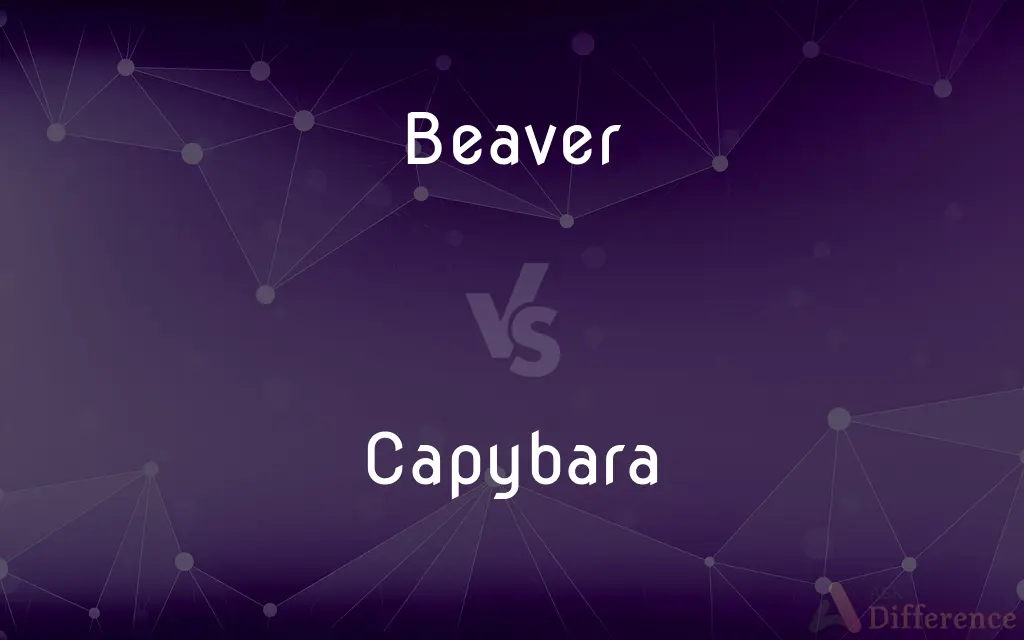Beaver vs. Capybara — What's the Difference?
By Urooj Arif & Maham Liaqat — Updated on March 25, 2024
Beavers are known for their dam-building in freshwater habitats, with a distinct flat tail, while capybaras are the largest rodents, living in groups near water in South America.

Difference Between Beaver and Capybara
Table of Contents
ADVERTISEMENT
Key Differences
Beavers are primarily found in North America and Eurasia, inhabiting rivers, streams, and ponds where they skillfully construct dams and lodges. Capybaras, on the other hand, are native to South America, thriving in savannas and dense forests near bodies of water, where they graze on grass and aquatic plants.
While beavers are celebrated for their ability to modify their environment by building dams, which helps in creating wetlands that benefit various species, capybaras are more known for their social behavior, living in large groups that can sometimes include dozens of individuals, enhancing their survival through group vigilance against predators.
Beavers have a distinctive physical appearance with a broad, flat tail used for swimming, signaling danger, and regulating body temperature. Capybaras, whereas, are distinguished by their large size, with adults weighing up to 145 pounds, and lack the beaver's prominent tail, featuring instead a vestigial tail.
The diet of a beaver is primarily composed of tree bark, leaves, and aquatic vegetation, reflecting their adaptation to a life partly in water and on land. Capybaras are grazers, feeding mainly on grasses and, to a lesser extent, aquatic plants, showcasing their adaptability to a semi-aquatic lifestyle.
Regarding reproduction, beavers are monogamous and have small family units that work together in building dams and lodges. Capybaras have a more complex social structure, with dominant males having access to females for breeding, resulting in larger and more dynamic groups.
ADVERTISEMENT
Comparison Chart
Habitat
Freshwater habitats in North America and Eurasia
Wetlands and forests in South America
Social Behavior
Monogamous, living in small family groups
Social, living in large groups
Physical Traits
Broad, flat tail for swimming and signaling
Large size, vestigial tail
Diet
Tree bark, leaves, aquatic vegetation
Grasses, aquatic plants
Environmental Impact
Builds dams, creating wetlands
Grazes near water bodies, affecting vegetation
Reproduction
Small litters, monogamous pairs
Larger litters, complex social structure
Size and Weight
Up to 60 pounds (27 kg)
Up to 145 pounds (66 kg)
Lifespan
Around 10-20 years
8-10 years in the wild
Compare with Definitions
Beaver
A member of a youth organization promoting scouting activities.
As a beaver, she learned various survival skills.
Capybara
An animal with webbed feet adapted to swimming.
The capybara dived into the water with ease, thanks to its webbed feet.
Beaver
A large, primarily nocturnal, semi-aquatic rodent known for building dams and lodges.
The beaver used its sharp teeth to cut down trees for its dam.
Capybara
A social animal that lives in groups near water bodies.
Observing a group of capybaras bask in the sun was a peaceful sight.
Beaver
A symbol of industriousness and diligence.
He was the beaver of the team, always working hard and completing projects.
Capybara
The largest living rodent, native to South America, known for its docile nature.
The capybara lounged by the riverbank, surrounded by its family.
Beaver
(Slang) A hard worker.
She's a real beaver, staying late every night this week.
Capybara
Considered a "friendly" species, often cohabitating peacefully with other animals.
The capybara shared its habitat harmoniously with a variety of bird species.
Beaver
Pertaining to beaver fur or a hat made from it.
His grandfather wore an old beaver hat to special occasions.
Capybara
A grazer, whose diet consists mostly of grass.
Capybaras spend much of their time grazing on the lush grasses near rivers.
Beaver
Beavers are large, semiaquatic rodents in the genus Castor native to the temperate Northern Hemisphere. There are two extant species: the North American beaver (Castor canadensis) and the Eurasian beaver (C. fiber).
Capybara
The capybara (Hydrochoerus hydrochaeris) is a giant cavy rodent native to South America. It is the largest living rodent.
Beaver
Either of two large semiaquatic rodents, Castor canadensis of North America or C. fiber of Eurasia, having thick brown fur, webbed hind feet, a broad flat tail, and sharp incisors used for gnawing bark and felling trees, with which they construct dams and underwater lodges.
Capybara
A South American mammal that resembles a giant long-legged guinea pig. It lives in groups near water and is the largest living rodent.
Beaver
The fur of a beaver.
Capybara
A large semiaquatic rodent (Hydrochoerus hydrochaeris) of tropical South America, having short limbs and a vestigial tail and often attaining lengths of more than 1.2 meters (4 feet).
Beaver
A top hat originally made of the underfur of a beaver.
Capybara
A semi-aquatic South American rodent, Hydrochoerus hydrochaeris, the largest living rodent.
Beaver
A napped wool fabric, similar to felt, used for outer garments.
Capybara
A large South American rodent (Hydrochærus capybara) Living on the margins of lakes and rivers. It is the largest extant rodent, being about three feet long, and half that in height. It somewhat resembles the Guinea pig, to which it is related; - called also cabiai and water hog.
Beaver
Vulgar Slang The female genitals.
Capybara
Pig-sized tailless South American amphibious rodent with partly webbed feet; largest living rodent
Beaver
Offensive Slang A woman or girl.
Beaver
A piece of armor attached to a helmet or breastplate to protect the throat or lower face.
Beaver
The visor on a helmet.
Beaver
Of or relating to a beaver or beavers
Beaver fur.
A beaver hat.
Beaver
Constructed by beavers
Beaver dams.
Beaver
To work diligently and energetically.
Beaver
To spot a beard in a game of beaver.
Beaver
To work hard.
Beaver
To cut a continuous ring around a tree that one is felling.
Beaver
(backgammon) After being doubled, to immediately double the stakes again, a move that keeps the doubling cube on one’s own side of the board.
Beaver
(countable) A semiaquatic rodent of the genus Castor, having a wide, flat tail and webbed feet.
Beaver
The fur of the beaver.
Beaver
(countable) A hat, of various shapes, made from a felted beaver fur (or later of silk), fashionable in Europe between 1550 and 1850.
Beaver
(North American) Beaver pelts as an article of exchange or as a standard of value.
Beaver
Beaver cloth, a heavy felted woollen cloth, used chiefly for making overcoats.
Beaver
A brown colour, like that of a beaver.
Beaver
A move in response to being doubled, in which one immediately doubles the stakes again, keeping the doubling cube on one’s own side of the board.
Beaver
Senseid|en|member of the youngest wing of the Scout movement}} {{alternative case form of Beaver.
Beaver
Senseid|en|part of a helmet}} {{alternative spelling of bevor.
Beaver
An amphibious rodent, of the genus Castor.
Beaver
The fur of the beaver.
Beaver
A hat, formerly made of the fur of the beaver, but now usually of silk.
A brown beaver slouched over his eyes.
Beaver
Beaver cloth, a heavy felted woolen cloth, used chiefly for making overcoats.
Beaver
A man's beard.
Beaver
The hair on a woman's pubic area; - vulgar.
Beaver
A woman; - vulgar and offensive.
Beaver
A person who works enthusiastically and diligently; - used especially in the phrase eager beaver.
Beaver
That piece of armor which protected the lower part of the face, whether forming a part of the helmet or fixed to the breastplate. It was so constructed (with joints or otherwise) that the wearer could raise or lower it to eat and drink.
Beaver
The soft brown fur of the beaver
Beaver
A full beard
Beaver
A man's hat with a tall crown; usually covered with beaver or silk
Beaver
A movable piece of armor on a medieval helmet used to protect the lower face
Beaver
A hat made of beaver fur or similar material
Beaver
Large semiaquatic rodent with webbed hind feet and a broad flat tail; construct complex dams and underwater lodges
Beaver
Work hard on something
Common Curiosities
How do capybaras adapt to their aquatic environment?
Capybaras have webbed feet for swimming and can stay submerged underwater to hide from predators.
Do beavers eat fish?
No, beavers are herbivores and do not eat fish; their diet consists mainly of tree bark, leaves, and aquatic vegetation.
Can beavers and capybaras live in the same habitat?
No, they inhabit different continents and ecosystems, with beavers in North America and Eurasia, and capybaras in South America.
What is the primary reason beavers build dams?
Beavers build dams to create ponds, which provide safety from predators and access to their food sources during winter.
Can capybaras and beavers be found in zoos?
Yes, both species are commonly found in zoos and wildlife parks, where they can be observed in environments designed to mimic their natural habitats.
Are beavers and capybaras endangered?
Beavers have been successfully reintroduced in some areas where they were previously extinct, while capybaras are not currently considered endangered but face threats from habitat loss and hunting.
How do beavers communicate with each other?
Beavers communicate through vocalizations, scent marking, and tail slapping on the water as a warning signal.
Can capybaras be kept as pets?
While capybaras are sometimes kept as pets, they require a lot of space, access to water for swimming, and social interaction, making them challenging to care for in a typical household.
How do beavers affect their ecosystem?
By building dams, beavers create wetlands, which support biodiversity and provide benefits such as flood control and water purification.
Are there any conservation efforts for beavers and capybaras?
Yes, there are conservation efforts aimed at preserving habitats and reintroducing populations to ensure the survival of both species.
How long do beavers and capybaras live?
Beavers can live up to 20 years in captivity, while capybaras have a lifespan of about 8-10 years in the wild.
What impact do capybaras have on agriculture?
Capybaras can have a negative impact on agriculture by grazing on crops and potentially damaging irrigation systems.
What predators do capybaras face?
Capybaras face several predators, including jaguars, anacondas, and caimans, depending on their habitat.
Share Your Discovery

Previous Comparison
Notebook vs. Diary
Next Comparison
Argument vs. ThesisAuthor Spotlight
Written by
Urooj ArifUrooj is a skilled content writer at Ask Difference, known for her exceptional ability to simplify complex topics into engaging and informative content. With a passion for research and a flair for clear, concise writing, she consistently delivers articles that resonate with our diverse audience.
Co-written by
Maham Liaqat













































